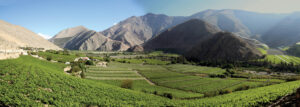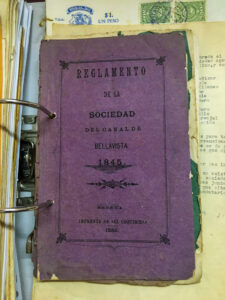T
he Elqui River and Tributaries Board of Control (Junta de Vigilancia del Río Elqui y sus Afluentes, JVRE), administers 121 irrigation canals in Elqui Province in north-central Chile. This productive area produces grapes, citrus fruits, avocados, and vegetables for export around the world. The JVRE’s formal history goes back to the 1930s, but some of its shareholders, like the Bellavista Canal Association, have histories that go back to the early 19th century.
In this interview, Dagoberto Bettancourt, the manager and general water distributor of the JVRE, speaks with
Irrigation Leader Managing Editor Joshua Dill about the history of irrigation in the Elqui Valley and his agency’s current efforts.

Joshua Dill: Tell us about your background and how you came to be in your current position.
Dagoberto Bettancourt: I am a software engineer and have been working in the Coquimbo region since 1998. In 2000, I had the chance to submit a work proposal to the JVRE, and as a result, it became one of my clients in my practice as an information technology consultant. Starting from that point, I ended up providing the JVRE services in a number of other areas, such as quality management, technology governance, and innovation. In those years, the organization succeeded in developing a focus and establishing its first strategic definitions and guidelines. After this process, I had the opportunity to consult for the new manager of the organization, after a few important internal changes. I submitted a proposal to stay on as assistant manager for administration and was brought on full time in that position in 2012. Finally, the leadership at the time decided to have me stay in the position of manager and general water distributor, a role I have continued to play until the present day.
As a result of all this, I have had the opportunity to get to know the JVRE first as an external management and corporate governance consultant, and then as the chief executive, answering directly to the board of directors and responsible for all operations and administration. During this period, we began to develop a project to change our working concepts and paradigms, incorporating academic research and knowledge with the aim of starting definitively to make our decisions based on data, diagnostics, and objective and concrete facts, so as to define our strategic orientation, vision, and mission within a defined, clear, measurable, and thus evaluable strategic plan.

Joshua Dill: Tell us about the JVRE and its history.
Dagoberto Bettancourt: The organization has a long history. The construction of the majority of the canals in the Elqui Valley goes back to pre-Columbian times, when the first inhabitants of the area began to undertake irrigation projects, which were later improved by Spanish colonists and by the small farmers who use them today to irrigate their crops. For more than 100 years, the JVRE has been working to conserve, protect, administer, and distribute the water of the Elqui River. Despite the cycles of extreme drought that this region has had to confront, our organizations’ high standard of work has allowed us to guarantee supply for urban potable water and to guarantee that each user receives the water belonging to him or her, as availability allows.
The organization was formally established at the time of the construction of the La Laguna Reservoir in the 1930s. To carry that project forward, the national government requested the legal establishment of this users’ organization, so that the users could take responsibility for the operation and administration of the reservoir. Initially, it was called the Coquimbo River Canal Association (Asociación de Canalistas del Río Coquimbo). This developed into the JVRE, which was established in 1993 by a presidential decree. Today, the JVRE exercises jurisdiction over more than 121 canals with a combined length of more than 800 kilometers (500 miles). Its shareholders comprise approximately 5,288 users.
The Elqui Valley is a territory with a centuries-long history of water usage. We are on the edges of the Atacama Desert; the change in the appearance of the land is the result of the use of scarce available water for a variety of ends, primarily agricultural in nature but also related to industry and mining. The administration of water is part of our cultural patrimony.
Joshua Dill: How big is the JVRE’s service area and what is its population? What crops are grown there?
Dagoberto Bettancourt: The JVRE’s service area is defined by its jurisdiction. Elqui Province has about a million hectares, coinciding with the Elqui River basin. The land suitable for irrigated agriculture in this area is on the order of 20,000 hectares. Ninety percent of this area corresponds with the JVRE’s service area, which is made up of 121 canals, 23 collection points, 89 constituted water communities (canals with more than one user), and a number of single users. We have 5,300 end users of all types, including agricultural users, water utility companies, and mining operations.
There are five irrigation sectors in this territory. Upstream from the Puclaro Reservoir, the main plantings are deciduous fruit-bearing plants, including table grapes, pisco grapes, and wine grapes. There are also a lot of citrus trees and avocados. Downstream from Puclaro, you can also find these crops, but vegetables predominate: potatoes, lettuce, tomatoes—crops with two or three rotations during the year. Our surfaces stay irrigated all year, thanks to climatic conditions.
Joshua Dill: What are the JVRE’s top issues?
Dagoberto Bettancourt: We aim to maintain the rigor that has thus far characterized our central activities: the distribution of water and the process of water planning. We develop our hydrological models using up-to-date statistical information, which allows us to make water availability projections for the upcoming season and for seasons after that. If we want to structure our experience and knowledge, we need to document and manage it. The JVRE always strives to evaluate and improve its performance, identifying opportunities as they arise in order to concretely correct the failures that we have so far detected, which have to do with infrastructure, management, and the attempt to influence public policy decisions.
We work with the authorities and other stakeholders in the basin in order to face up to the global-level challenge of water availability with flexibility and resilience. The availability of water has changed, and we need to adapt to that. We want to take the next step with respect to management with the stakeholders in the basin, incorporating an integrated water management focus from a technical point of view. We are aiming at the administration of the surface water and groundwater of the basin and its uses, as well as governance issues related to the establishment of collaborative work.
Joshua Dill: What are the main problems of the farmers in your service area?
Dagoberto Bettancourt: Our agricultural sector has gone through a process of change. Until the 1980s, its produce supplied the internal market. From that point onward, a vision emerged of making use of our capacity to export horticultural products to the Northern Hemisphere. The climate of Elqui Province allows it to bring grapes to that market very early in the season, so people started to invest in the region to take full advantage of the potential for exports. The market has continued to develop, generating demand for new varieties of grapes. For a variety of reasons, however. many farmers have failed to adapt to these changes in time and are offering products that the international market is apparently no longer interested in, a situation that directly affects the competitiveness of the country as a whole. Climatic variability also comes into play: The temperature has risen and precipitation has decreased, which also adds to the need for more investment, not only to further the replacement of plant varieties, but to make our irrigation more efficient and technologically advanced.
Another important element is the change in land use. Plots that ought to be used for agriculture are being sold for housing developments or for so-called country houses (parcelas de agrado), thus tremendously complicating water administration. The model is intended for agricultural irrigation, but today it must exist alongside residents who need higher-quality water supplies, meaning that they are demanding water as if they are in the city, even though access to those services is different in rural areas.
Joshua Dill: What is your vision for the future?
Dagoberto Bettancourt: I am optimistic. I believe that we have the capacity to turn this adverse situation into an opportunity to resolve to incorporate new technology, shift paradigms, and understand that change is necessary. This means moving on from our base condition to incorporate new processes and procedures and understanding that we’re capable of confronting a fairly complex future. Today, modeling tools show us that despite the difficult climate scenarios we see in the short, medium, and long terms, efficient and integrated management can allow us to be resilient. I believe that we can do that and that we are on a good path to resolve the problems we face on a global level. I value my ability to share experiences with people from other countries who are experiencing the same challenges. It is important to learn from their experiences.
The JVRE has been tremendously receptive to academic knowledge and to other parties who have supplied us with information and their knowledge, which has represented a huge learning experience. I believe that the future is complex but undoubtedly represents a tremendous opportunity for learning and growth. I feel certain that we are capable of facing this challenge and continuing to provide for productive and priority uses of water, like drinking supplies and sanitary uses for our population, and maintaining this fertile and productive valley.
Dagoberto Bettancourt is the manager and general distributor of
water for the Elqui River and Tributaries Board of Control.
